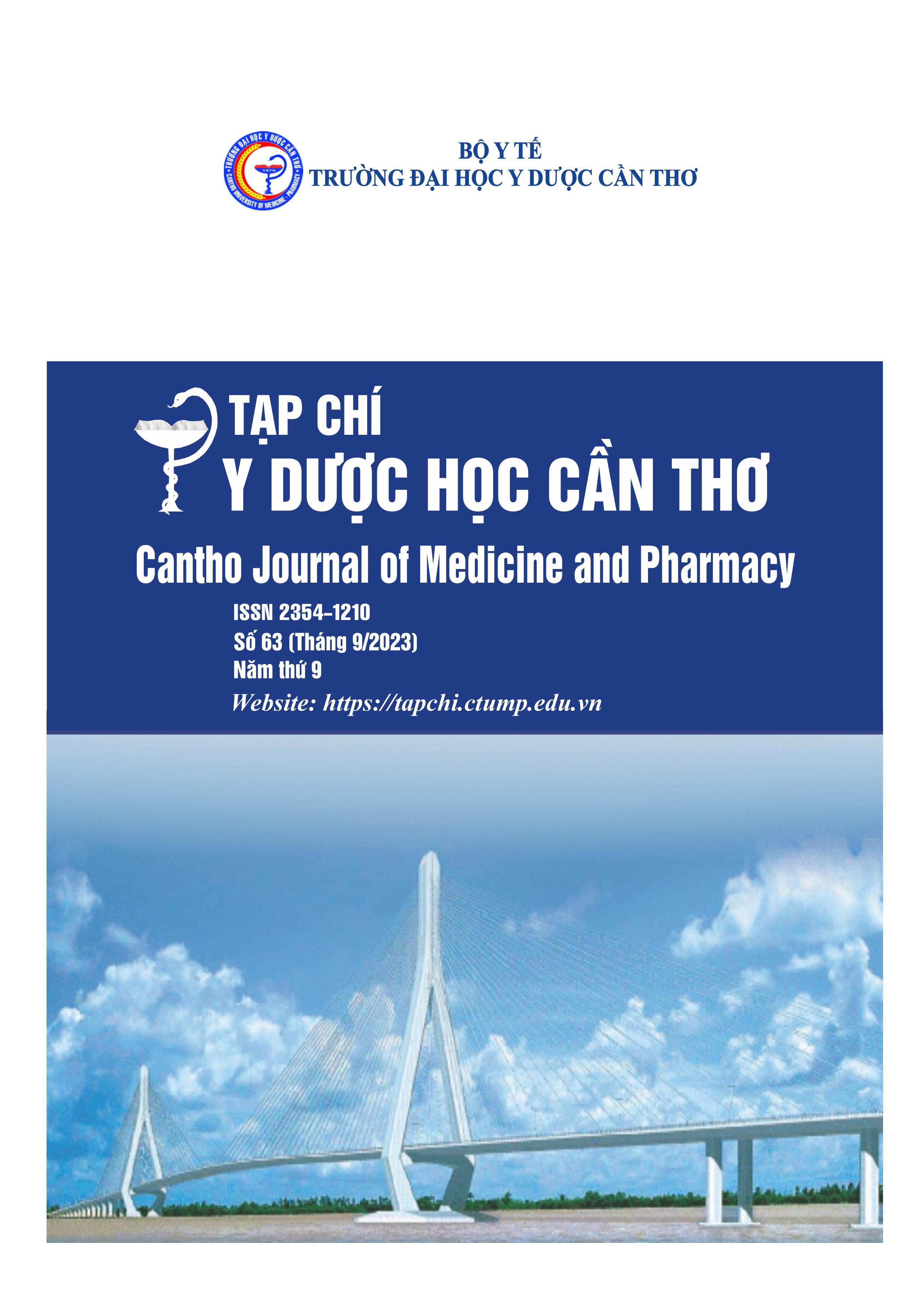ANATOMICAL CHARACTERISTICS OF ROOTS, MORPHOLOGY OF ACCESSORY ROOT CANAL SYSTEM AND ISTHMUS OF VIETNAMESE MANDIBULAR FIRST MOLARS
Main Article Content
Abstract
Background: The understanding of human root canal system anatomy and its variations as well as the accessory canal morphology, its isthmus and its anastomosis has contributed significantly to the success of current endodontic treatment. Objectives: Describing the anatomical characteristics of the mandibular first molars’ roots, morphology of its accessory canal system, its isthmus and its anastomosis in Vietnamese. Materials and methods: Cross-sectional study design: 179 mandibular first molars were collected, processed, examined with cone beam computed tomography (CBCT) and following characteristics: (1) number and length of roots; (2) number and classification of main canals; (3) prevalence, location and types of accessory canals; (4) prevalence, location of isthmus and the anastomosis. Result: Mandibular first molars had their mesial roots (13.22±1.20mm) longer than the their distal roots (12.88±1.10mm) (p<0.001). Teeth with 3 roots account for 7.3% of the sample. Mandibular first molars have 3, 4, and 5 canals, accounting for 54.8%, 43.0% and 2.2%, respectively. Observation of the mesial roots showed that type I canals accounted for the highest proportion (65.4%), type II with 23.5% and 0.6% type 2-3. Meanwhile, in the distal roots, type I (61.5%) and 0.6% type 3-1 and 0.6% type 2-3 appeared. Accessory canals occured with the rate of 40.2%, usually in the apical third (56.5%) and type I accounted for the highest rate with 62.0%. There was no statistically significant difference between teeth on the left and the right sides (p=0.851).Conclusion: Cone beam computed tomography scan has paved the way for the investigating of characteristics of roots, root canal system morphology and its variants, accessory canals, isthmus, and interstitial canals which are very complex and need to be carefully evaluated before starting endodontic treatment.
Article Details
Keywords
Mandibular first molar, accessory canal, isthmus, anastomosis
References
2. Kulakov A. A., Badalyan V. A. Increasing the effectiveness of mandibular molars root resection surgery using retrograde endodontic revision. Stomatologiia. 2018. 97(1), 33-36. https://doi.org/ 10.17116/stomat201897133-36.
3. Madani Z. S., Mehraban N., Moudi E., et al. Root and canal morphology of mandibular molars in a selected Iranian population using cone-beam computed tomography. Iran Endod J. 2017. 12(2), 143-148, https://doi.org/10.22037/iej.2017.29.
4. Marceliano-Alves M. F., Lima C. O. Mandibular mesial root canal morphology usingmicrocomputed tomography in a Brazilian population. Aust Endod J. 2019. 45(1), 51-56, https://doi.org/10.1111/aej.12265
5. Filpo-Perez C., Bramante C. M., Villass-Boas M. H. Micro-computed tomographic analysis of the root canal morphology of the distal root of mandibular first molar. J Endod. 2015. 41(2), 231236, https://doi.org/ 10.1016/j.joen.2014.09.024
6. Ahmed H. A., Abu-bakr N. H., Yahia N. A., et al. Root and canal morphology of permanent mandibular molars in a Sudanese population. Int Endod J. 2007. 40(10), 766-771. https://doi.org/ 10.1111/j.1365-2591.2007.1283.x
7. Al-Qudah A. A., Awawdeh L. A. Root and canal morphology of mandibular first and second molar teeth in a Jordanian population. Int Endod J. 2009. 42(9), 775-784. https://doi.org/10.1111/j.13652591.2009.01578.x.
8. Gu L., Wei X., Ling J., Huang X. A Microcomputed tomographic study of canal isthmi in the mesial root of mandibular first molars in a Chinese population. J Endod. 2009. 35(3), 353-356. https://doi.org/ 10.1016/j.joen.2008.11.029.
9. Peiris R., Malwatte U., Abayakoon J., Wettasinghe, A. Variations in the Root Form and Root Canal Morphology of Permanent Mandibular First Molars in a Sri Lankan Population. Anatomy
Research International. 2015. (3), 803671, https://doi.org/ 10.1155/2015/803671
10. Dastgerdi A. C. Isthmuses, accessory canals, and the direction of root curvature in permanent mandibular first molars: an in vivo computed tomography study. Restor Dent Endod. 2020. 45(1), e7, https://doi.org/ 10.5395/rde.2020.45.e7
11. Harris S. P., Bowles W. R., Fok A., McClanahan S. B. An anatomic investigation of the mandibular first molar using micro-computed tomography. J Endod. 2013. 39(11), 1374-1378. https://doi.org/ 10.1016/j.joen.2013.06.034.
12. Keleş A., Keskin C. A micro-computed tomographic study of band-shaped root canal isthmuses, having their foor in the apical third of mesial roots of mandibular frst molars. Int Endod J. 2018. 51(2), 240-246. https://doi.org/ 10.1111/iej.12842
13. Huỳnh Hữu Thục Hiền, Hoàng Tử Hùng. Đặc điểm hình thái chân răng và ống tủy răng cối lớn thứ nhất và thứ hai người Việt. Luận văn Tiến sĩ. Trường Đại học Y Dược Thành phố Hồ Chí Minh, Hồ Chí Minh. 2019. 59-61.
14. Nguyễn Hoàng Thy Vân, Huỳnh Hữu Thục Hiền. Đặc điểm hình thái chân răng và ống tủy xa trong răng cối lớn thứ nhất hàm dưới người Việt. Luận văn tốt nghiệp Bác sĩ Răng Hàm Mặt, Trường Đại học Y Dược Thành phố Hồ Chí Minh, Hồ Chí Minh. 2017. 40.
15. Ahmed H., Versiani M. A new system for classifying root and root canal Morphology. Int Endod J. 2017. 50(8), 761-770, https://doi.org/ 10.1111/iej
16. Gupta A. Prevalence of Three Rooted Permanent Mandibular First Molars in Haryana (North Indian) Population. Contemp Clin Dent. 2017. 8(1), 38-41. https://doi.org/: 10.4103/ccd.ccd_699_16
17. Khlaghi N. M., Khalilak Z., Vatanpour M., Mohammadi S., Pirmoradi S., et al. Root Canal Anatomy and Morphology of Mandibular First Molars in a Selected Iranian Population: An In Vitro Study. Iran Endod J Winter. 2017. 12(1), 87-91, https://doi.org/ 10.22037/iej.2017.18.


